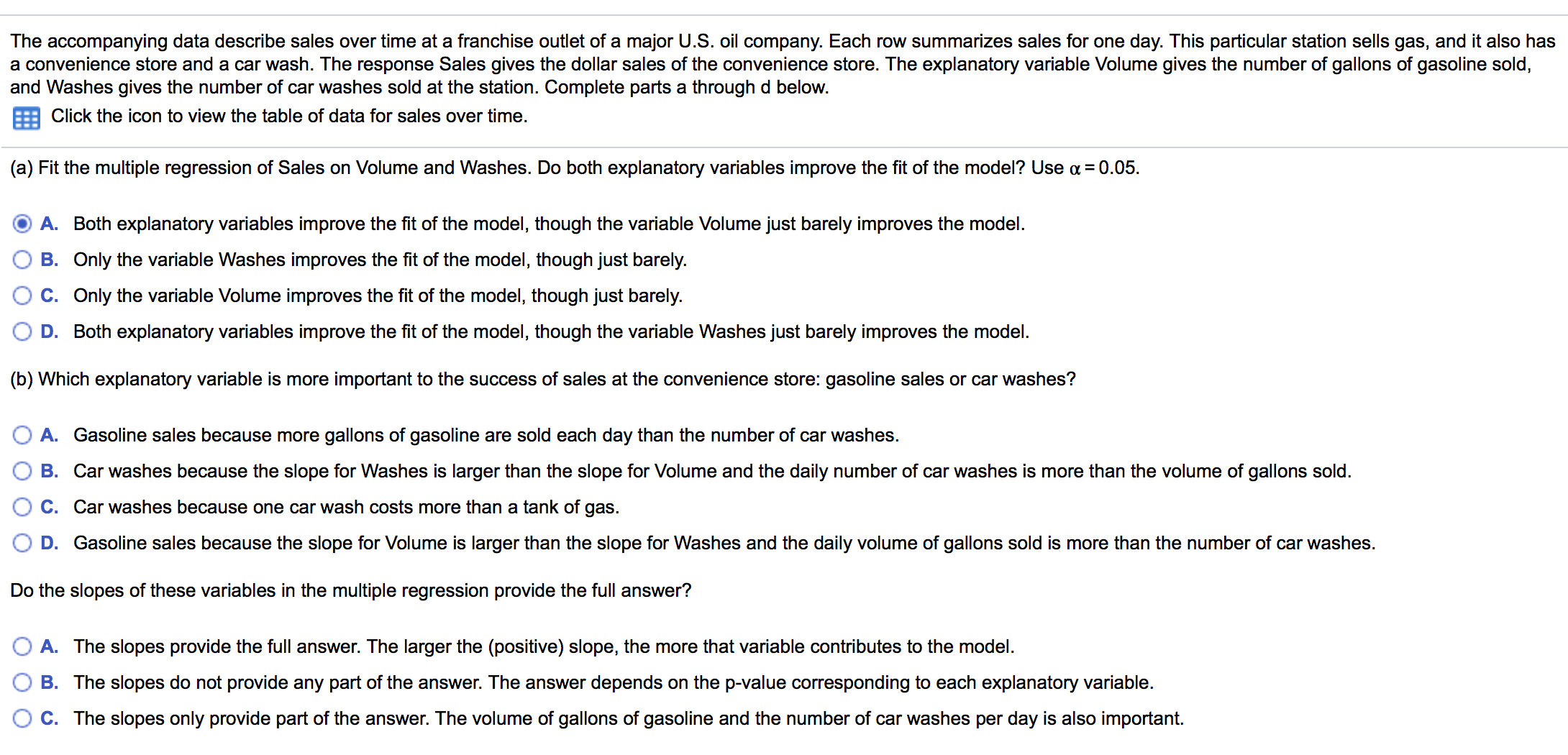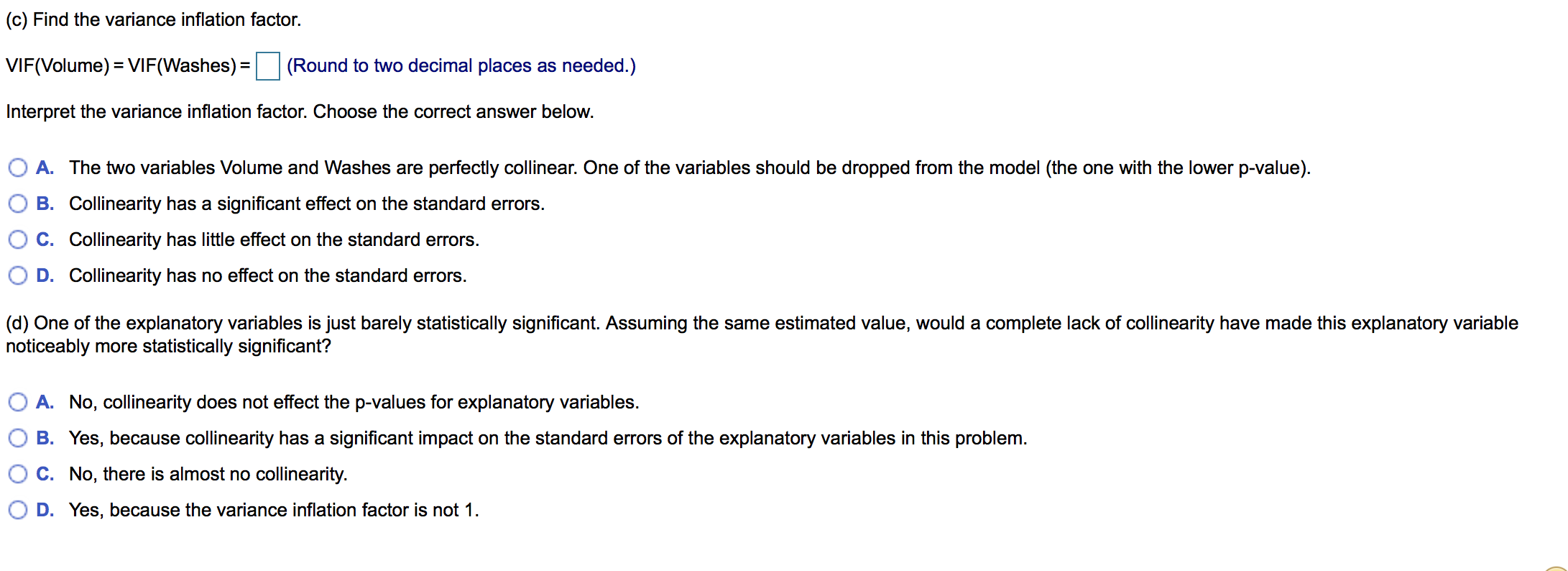The accompanying data describe sales over time at a franchise outlet of a major U.S. oil company. Each row summarizes sales for one day. This particular station sells gas, and it also has a convenience store and a car wash. The response Sales gives the dollar sales of the convenience store. The explanatory variable Volume gives the number of gallons of gasoline sold, and Washes gives the number of car washes sold at the station. Complete parts a through d below. a Click the icon to view the table of data for sales over time. (a) Fit the multiple regression of Sales on Volume and Washes. Do both explanatory variables improve the t of the model? Use a = 0.05. Q) A. Both explanatory variables improve the t of the model, though the variable Volume just barely improves the model. 0 B. Only the variable Washes improves the fit of the model, though just barely. O C. Only the variable Volume improves the t of the model, though just barely. O D. Both explanatory variables improve the fit of the model, though the variable Washes just barely improves the model. (b) Which explanatory variable is more important to the success of sales at the convenience store: gasoline sales or car washes? O A. Gasoline sales because more gallons of gasoline are sold each day than the number of car washes. O B. Car washes because the slope for Washes is larger than the slope for Volume and the daily number of car washes is more than the volume of gallons sold. 0 C. Car washes because one car wash costs more than a tank of gas. 0 D. Gasoline sales because the slope for Volume is larger than the slope for Washes and the daily volume of gallons sold is more than the number of car washes. Do the slopes of these variables in the multiple regression provide the full answer? 0 A. The slopes provide the full answer. The larger the (positive) slope, the more that variable contributes to the model. 0 B. The slopes do not provide any part of the answer. The answer depends on the p-value corresponding to each explanatory variable. 0 C. The slopes only provide part of the answer. The volume of gallons of gasoline and the number of car washes per day is also important. (c) Find the variance ination factor. V|F(Volume) = V|F(Washes) = D (Round to two decimal places as needed.) Interpret the variance ination factor. Choose the correct answer below. 0 A. The two variables Volume and Washes are perfectly collinear. One of the variables should be dropped from the model (the one with the lower p-value). O B. Collinearity has a signicant effect on the standard errors. 0 C. Collinearity has little effect on the standard errors. 0 D. Collinearity has no effect on the standard errors. (d) One of the explanatory variables is just barely statistically significant. Assuming the same estimated value, would a complete lack of collinearity have made this explanatory variable noticeably more statistically signicant? 0 A. No, collinearity does not effect the p-values for explanatory variables. 0 B. Yes, because collinearity has a signicant impact on the standard errors of the explanatory variables in this problem. 0 C. No, there is almost no collinearity. O D. Yes, because the variance ination factor is not 1. This particular station i Data for Sales Over Time X lives the number of g It. Sales (Dollars)Volume (Gallons)WashesSales (Dollars)Volume (Gallons)Washe 2210 3478 149 2184 3283 127 2286 3721 222 2258 3606 95 2261 3619 118 2234 3501 148 2112 2970 306 2285 3716 271 2306 3808 294 1982 2411 193 2274 3675 106 2236 3511 92 2237 3516 62 2187 3292 256 he lower p-value). 2304 3795 358 2354 4014 260 2411 4260 324 2271 3664 99 2271 3658 279 2327 3900 165 2314 3844 177 1876 1952 169 2363 4052 403 2306 3807 246 1986 2422 307 2321 3872 251 2051 2709 168 2289 3731 316 earity have made this 2113 2970 327 2204 3367 302 2154 3150 278 1971 2361 182 2160 3178 271 2258 3603 241 2065 2767 211 2019 2567 319 2076 2816 181 2357 4028 324 2196 3338 38 2145 3115 185 Print Done









